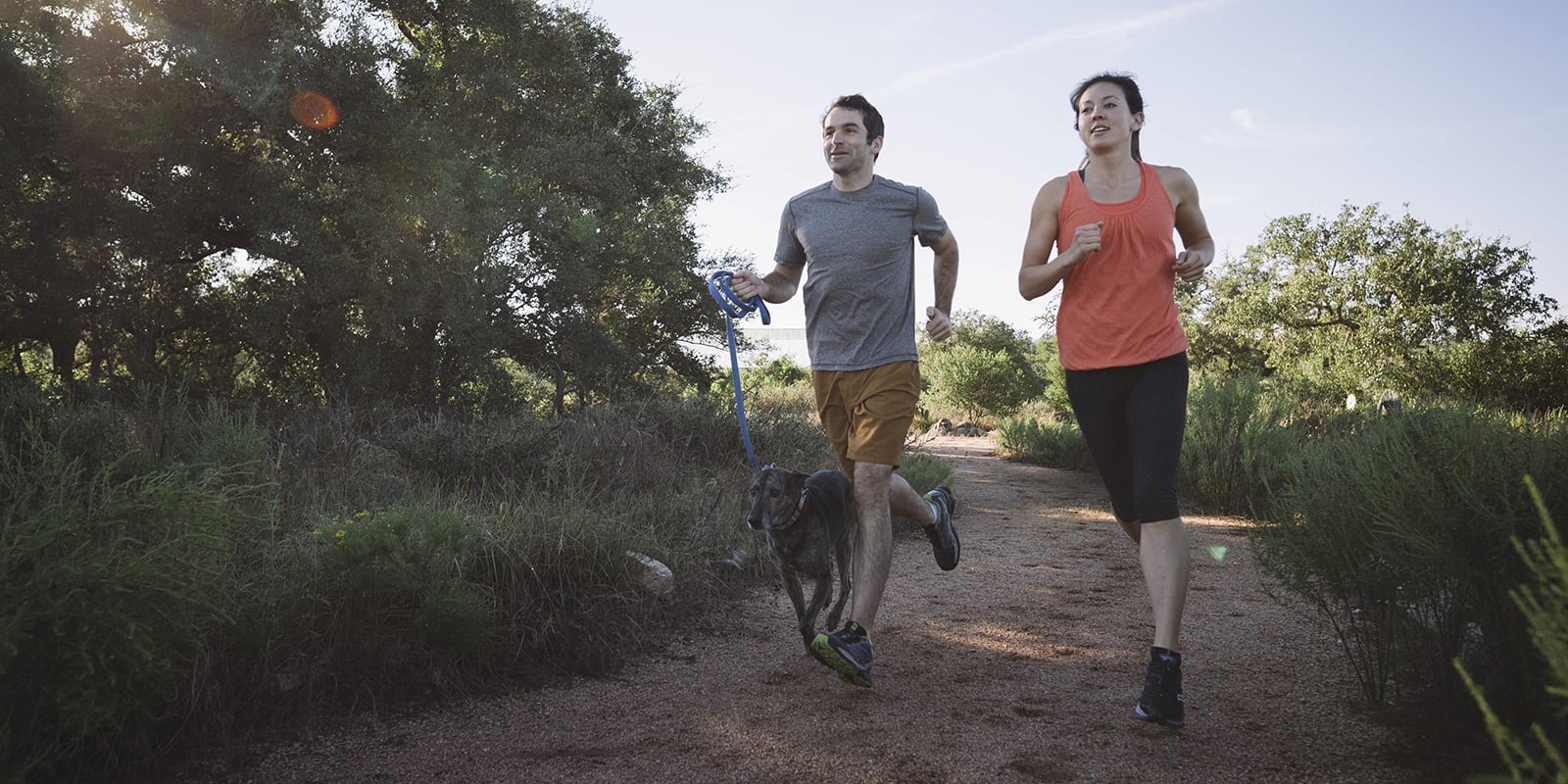If a walk around the block with your pooch is a joyous adventure, then imagine your furry sidekick bounding along the trail beside you, slobbering and grinning around every switchback. Your dog will get a better workout and you might just discover the perfect running partner.
Here are the things you need to do and know before trail running with your dog:
- Pre-run readiness: Consult with your veterinarian; brush up on obedience training and make sure you're picking appropriate trails.
- Gearing up: In addition to the basics, a few extra items can make your dog's experience safer and more enjoyable.
- Mind your trail manners: Using a leash, stepping aside for others, and picking up waste creates good karma and helps keep more trails open.
- Beware trail hazards: Watch for heat, creatures, plants and pathogens.
Note: This article focuses on your pet's needs and assumes (recommends) that you are already a trail runner before you begin your new partnership. To learn about trail running for you, read Trail Running for Beginners.
Getting Ready to Trail Run with Your Dog
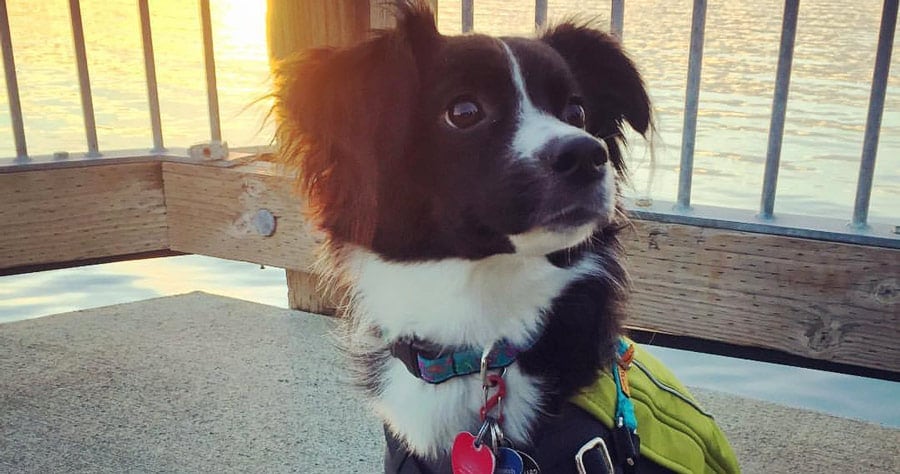
Singletrack trails mean close encounters with other users. And winding trails can hide hazards and tempting distractions until the last minute, so your canine companion must be well-controlled. Consider obedience school the prerequisite for trail running. If it's been several years since graduation, it's time to practice those skills again. Don't rely solely on the leash.
Visit the Vet
Just as people are advised to check with their doctors before beginning a new exercise regimen, you should ask your vet some key questions before you start running with your dog:
- Is your dog physically mature enough for trail running? Puppies' bones are still forming, so you need to wait until they're done developing. You're looking at a year of age, plus or minus several months, depending on size and other factors.
- What's a reasonable training schedule to build endurance? Your vet should be able to suggest a maximum distance and running time for your dog's physiology. The vet can also advise how to work up to your long-term goal: starting with just a mile a week and increasing gradually from there, for example.
- Does your dog need any specific vaccinations or preventative medicines? When you're in the city, you might not worry about things you would find in more remote areas, like ticks, for example. Your dog can also be exposed to Leptospirosis, most commonly by drinking water in a lake, pond or puddle that's been contaminated by an infected animal's urine. Be sure to ask your vet about the risks in your area and any preventative measures you can take.
Gearing Up to Trail Run with Your Dog
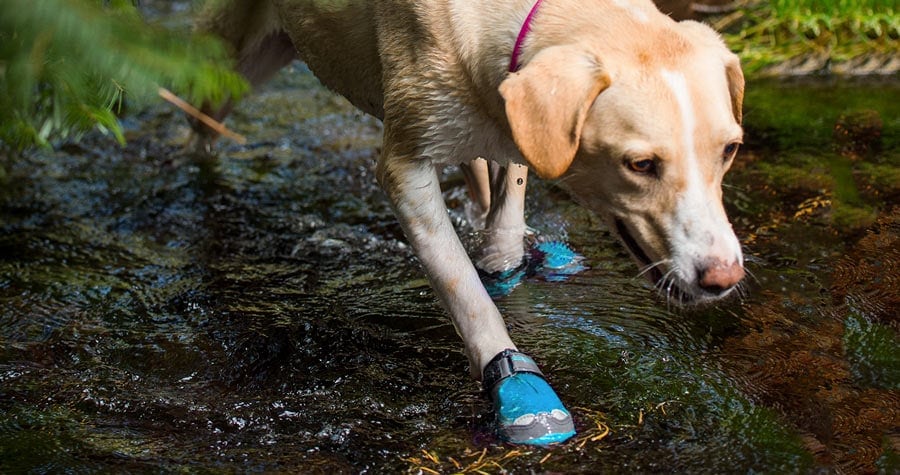
Your usual gear will work, although you might need more capacity in your trail-running pack. Your dog's needs are few: high-calorie snacks, water and select pet gear.
Leash: A waist-attached leash is a great option to consider. It's more secure and less cumbersome than a handheld model. Some leashes convert from handheld to waist-attached mode.
Harness: A harness is generally more comfortable than a collar.The key, though, is to have something that attaches securely and effectively controls your dog. You also need a close-to-dog handle on the harness or the leash. It provides added control for dicey situations: passing a cliff edge or a skittish human, for example.
Poop bags: Picking up your dog's treasures is the rule, so take plenty of waste bags.
Water container: Just like you, your dog needs to hydrate, too, and fresh water carried by you is the best source. Some owners train dogs to drink as they pour from a bottle. A lightweight, collapsible dish also works.
Booties: Lots of dogs run "barefoot," but outdoor terrain can be hard on citified paws. A set of booties can offer some protection from sharp rocks, thorns and snow. Your dog needs time to break in new footwear, just as you do—and to get used to wearing it at all. If booties chafe, buy liner socks for extra protection.
Safety light: Unless you're certain that all of your runs will be away from traffic, then having a safety light to give your companion added visibility is a wise move. You can also look for reflective trim on leashes, harnesses, collars and doggie coats.
Trail Rules and Etiquette for Dogs
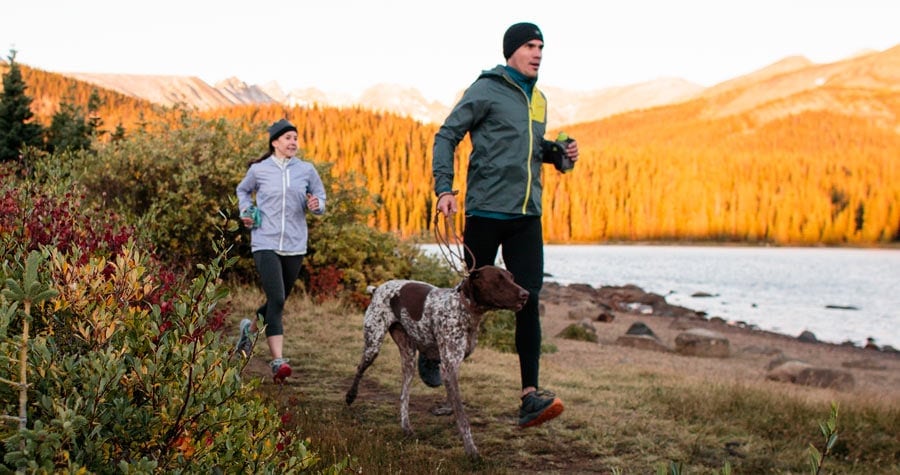
Before you hit the trail, do your homework ahead of time. Generally, dogs aren't allowed, even on a leash, on national park trails. Many national forests, as well as state and local parks, do allow leashed dogs on their trail systems, though rules vary.
In the rare circumstances where a dog is allowed off-leash, we recommend using one anyway. Hazards can suddenly appear, animals are too tempting to chase and other users can be dog-wary. A well-leashed dog is an advocate for keeping trails open.
Follow these rules when trail running with your dog:
- Always use a leash: Wildlife and other users will thank you.
- Yield the right of way to hikers, horses and bikes: You and your dog should step off the trail.
- Skip the earbuds: Your dog needs you to be extra-aware, not dancing down the trail.
- Pack out filled poop bags: It's bad form to leave 'em by the trail for later pickup; running on loop trails or trails with waste cans cuts down on bag-hauling time.
Trail Hazards for Dogs
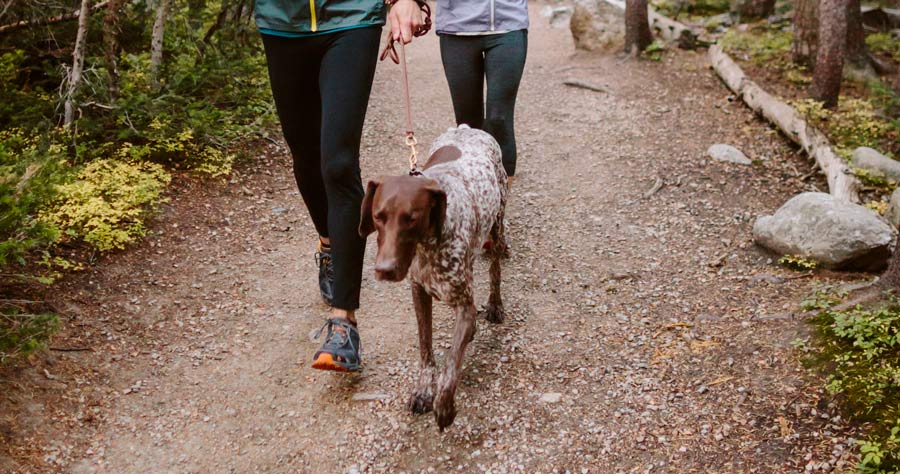
Your pooch is susceptible to most of the same dangers you are, with two distinctions:
- Your dog can't read up about hazards. A gopher snake and a rattler both look fun.
- Your dog can't tell you about fatigue or injuries.
You have to be extra vigilant of the following:
Overdoing it: Watch how quickly your dog's breathing and heart rate take to normalize during breaks, especially when you're just starting out running with your dog. If it seems excessive, take more breaks or shorten your runs. Other signs you need to dial it back include damaged paw pads or limping (on the trail or back at home).
Wildlife: Your leash is your best defense against a dash toward big carnivores like bears or prickly herbivores like porcupines. Smaller pests like ticks require a different approach. Even though Lyme disease doesn't show symptoms in many dogs, it's still worth checking closely to remove any hitchhikers after a run.
Wild plants: Dogs sometimes try to eat or chomp on plants, sticks and more, so the best policy is to stop your chewing pal immediately. Not all plants are harmless, nor free of chemical taint, and things like tree bark can splinter and cause digestive issues.
Usual suspects like nettles, along with poison oak, ivy and sumac, can also cause skin rashes on dogs (and fur will efficiently transport the offending oils into your world).
Thorns and burrs can cause injury and discomfort, but "foxtails" are more serious. Found on a variety of grasses in spring and summer, these barbed seedpods won't let go after they hitch a ride. They can be found on fur and between toes, and in more sensitive areas like nasal passages, ears, eyes and genitals.
Avoid areas with grasses that have these kind of seedpods, and remove foxtails with tweezers after a run. If you see excessive sneezing, head shaking, eye discharge or an abscess, head for the vet. Foxtails that work their way into a vital organ can be fatal.
Heat stroke: Dogs can only pant and sweat through their pads to cool off, so heat is hard to dissipate. Be conservative—some owners won't go on a run when the thermometer climbs above 70 degrees Fahrenheit. Know thy dog and decide what your too-high running temp will be.
If your friend keeps lying down in shady spots, stop and carry your pal home because excess fatigue is the first sign of heat stroke. If you also see vomiting, diarrhea and confusion, you can cool your dog off with room-temp water and a fan, then head for the vet.
Waterborne pathogens: Though many pet owners allow drinking from water sources along the way, dogs are susceptible to most of the same waterborne pathogens as humans. For a list of those, read How to Treat Water in the Backcountry. Your safe choice is to carry enough clean water for both you and your dog.
